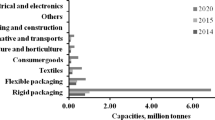Abstract
Dielectric heating techniques have been applied to plastics drying applications, polymer blending, wood flour drying, and to an existing biomass conversion process. While both radio frequency and microwave equipment is expensive per unit of capacity, certain advantages may be gained in terms of the speed of drying, quality control, and the overall capitalized cost which may make dielectric heating feasible.
Similar content being viewed by others
References
Magee, R.J. and N. Kosaric, Advances in Biochemical Engineering/Biotechnology, 32, (Springer-Verlag, New York, 1985), p. 61.
Barrier, J.W., et al, “Integrated Fuel Alcohol Production Systems, Phase III Experimental Facility Design Report,” Circular Z-18, Tennessee Valley Authority, Muscle Shoals, Al (1985)
Author information
Authors and Affiliations
Rights and permissions
About this article
Cite this article
George, C.E., Lightsey, G.R. & Wehr, A.G. Microwave Processing of Polymers and Biomass Materials. MRS Online Proceedings Library 124, 189–194 (1988). https://doi.org/10.1557/PROC-124-189
Published:
Issue Date:
DOI: https://doi.org/10.1557/PROC-124-189




